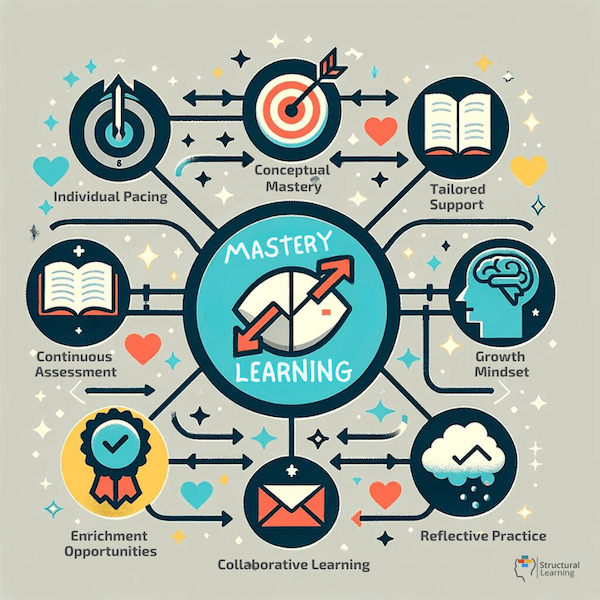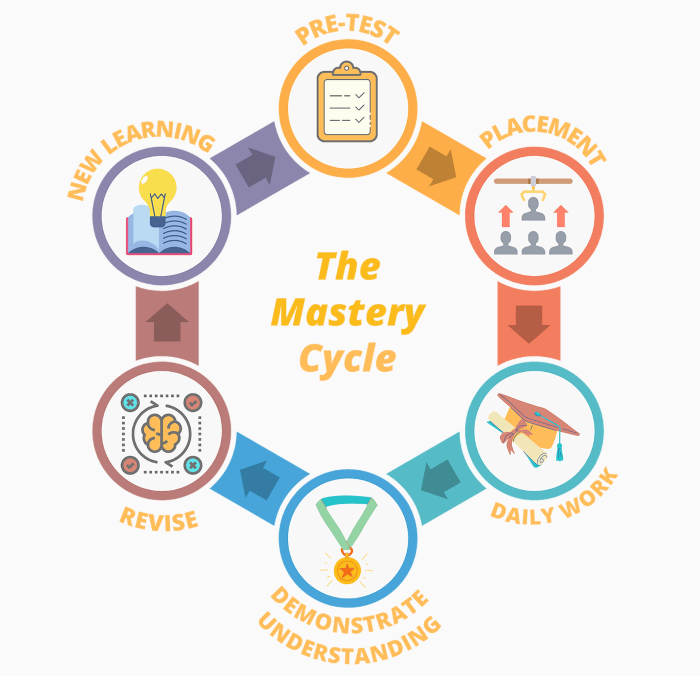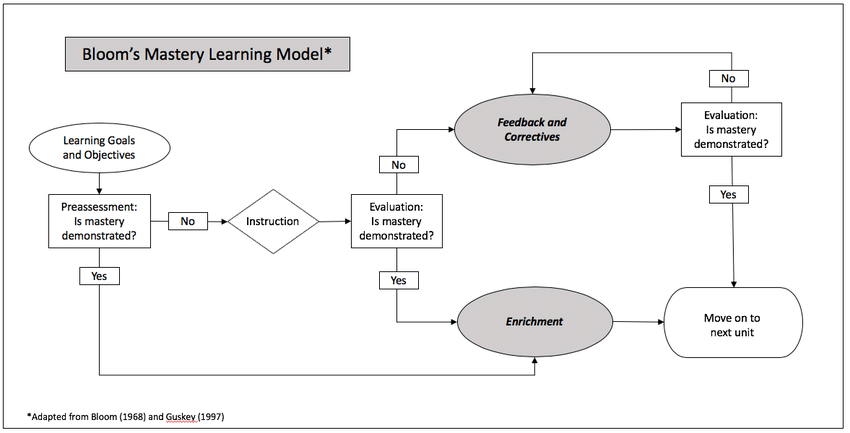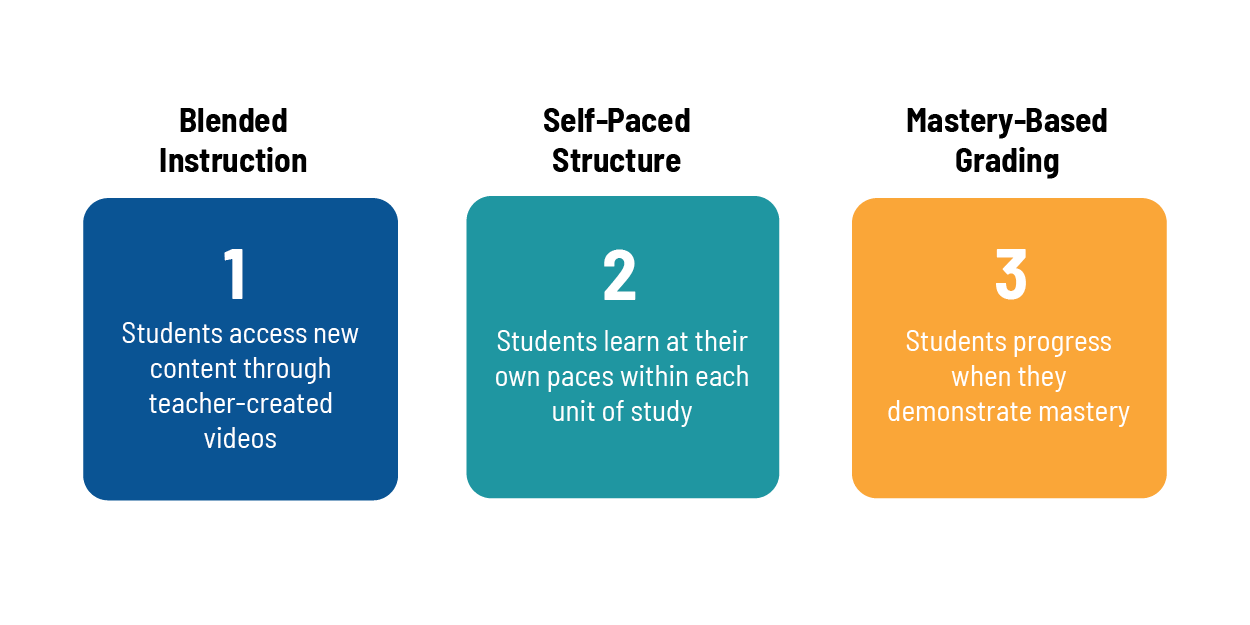Mastery Learning
Explore mastery learning principles to enhance student understanding and academic growth. Learn effective strategies for classroom success.
Explore mastery learning principles to enhance student understanding and academic growth. Learn effective strategies for classroom success.
Mastery learning is an educational philosophy that focuses on ensuring that students truly understand and master the material before moving on to new concepts. It breaks down information into clear learning outcomes, allowing students to progress at their own pace and providing them with the opportunity to demonstrate their understanding before moving forward.
This approach emphasizes the importance of tailored instruction and individualized support, recognizing that all students learn at their own speed and in their own unique way. Mastery learning empowers teachers to use a variety of instructional methods and provide extra support to help each student achieve mastery.
By focusing on the mastery of specific skills and knowledge, this approach aims to ensure that every student reaches their full potential. It prioritizes depth of understanding over simply covering a large amount of material, promoting a more thorough and meaningful learning experience for students.
Mastery Learning is built on the idea that all students can achieve high levels of understanding if they are given the appropriate amount of time and support.
This approach to teaching is grounded in solid theoretical foundations that guide its implementation in the classroom. Understanding these theoretical foundations is crucial for teachers who want to effectively utilize Mastery Learning in their teaching practices.
In this article, we will explore the key theoretical underpinnings of Mastery Learning and how they can inform your approach to teaching.

Benjamin Bloom was a prominent educational psychologist who is best known for his development of mastery learning. Mastery learning is an instructional strategy that focuses on ensuring students achieve a certain level of proficiency in prerequisite knowledge before moving on to new information.
Bloom's educational philosophy emphasized the importance of individualized instruction and the mastery of foundational knowledge as a fundamental step in learning.
Bloom's work laid the foundation for mastery learning, which has had a significant impact on educational practices. His ideas have influenced the design of curricula and instructional methods, as well as the assessment of student learning.
By emphasizing the importance of ensuring mastery of prerequisite knowledge, Bloom's work has had a lasting impact on how educators approach teaching and learning. This approach aims to support all students in achieving a deep understanding of the material, rather than simply moving them along at the same pace. As a teacher, understanding Bloom's contribution to mastery learning can help you design your instruction to better support your students' individual learning needs.
This approach emphasizes the idea that all students can achieve mastery with the appropriate support and resources.
Key concepts in mastery learning include personalized instruction, formative assessment, and flexible pacing. Let's break down these concepts to understand how they can be applied in the classroom.
Competency-based education focuses on students mastering specific skills and knowledge, rather than just completing a certain amount of time in a classroom. It is related to mastery-based learning in that it emphasizes students demonstrating their understanding and proficiency before moving on to new material.
The key principles of competency-based education include clearly defined learning outcomes, personalized learning paths for students, flexible pacing, and continuous feedback and assessment. This approach allows for a more individualized and flexible learning experience for students.
Historically, competency-based education has evolved from a need to ensure that students are truly proficient in required skills and knowledge. It differs from traditional instructional techniques in that it puts the focus on the mastery of specific competencies rather than the completion of predetermined courses or grade levels.
By understanding and implementing the principles of competency-based education, teachers can better support their students in achieving true mastery of the material, leading to greater success and retention of knowledge.

In the mastery learning approach, students are expected to achieve a high level of mastery in the specified learning outcomes. This means that they are not just aiming for a passing grade, but rather a deep understanding and proficiency in the subject matter. Instructors define clear learning objectives that outline the specific knowledge and skills that students are expected to demonstrate.
Formative assessments are used to monitor student progress and provide feedback, while corrective activities are implemented to address any areas of misunderstanding or weakness. Enrichment activities are also utilized to provide additional challenges for students who have already demonstrated mastery. Summative assessments are used to evaluate overall learning and mastery of the content.
Grading in the mastery learning system is based on the extent to which students have achieved the specified learning outcomes and level of mastery. This may include a combination of formative and summative assessments, as well as consideration of participation and engagement in corrective and enrichment activities. The focus is on measuring true mastery rather than simply completion of assignments.
Formative assessments are used by teachers to gather ongoing information about student progress and understanding. These assessments are not graded and are designed to provide teachers with insight into what their students are grasping and where they may be struggling.
A key feature of formative assessments is that they are used to shape future instruction and support student learning. On the other hand, diagnostic assessments are used to identify specific areas of student misunderstanding or difficulty. These assessments are more focused and are used to delve into the root causes of any issues that have been identified through formative assessments.
Both types of assessments are crucial for informing instructional decisions. Formative assessments provide a general overview of student progress, allowing teachers to adjust their teaching methods and provide additional support where necessary.
Diagnostic assessments then help to pinpoint specific student needs, allowing for targeted and individualized support. By using both formative and diagnostic assessments, teachers can ensure that they are meeting the needs of all their students and supporting their learning effectively.

By breaking down complex topics into smaller, manageable chunks and providing additional assistance to those who need it, teachers can help students achieve a deeper understanding of the material. This method promotes a growth mindset and encourages students to take ownership of their learning, leading to improved academic outcomes and increased self-confidence.
Mastery learning models and approaches in education focus on ensuring that all students achieve a deep understanding of the material before moving on to new concepts. The key principles of mastery learning include providing multiple opportunities for students to master the material, personalized instruction based on individual student needs, and continuous feedback and assessment to guide learning.
In contrast to traditional teaching methods, mastery learning emphasizes student understanding rather than just completing assignments. Implementation strategies for mastery learning may include using formative assessments to identify student needs, providing additional support for struggling students, and allowing students to progress at their own pace.
Successful programs that utilize mastery learning models include the Khan Academy, where students can work through material at their own pace and receive personalized feedback, and the Montessori method, which emphasizes individualized learning and mastery of specific skills.
By focusing on mastery of material rather than just completion, mastery learning models have been shown to have a positive impact on student learning outcomes, leading to deeper understanding and increased student achievement.

Incorporating mastery learning into the classroom can be transformative. Here's a practical guide:
Mastery learning is not just about the material learned, it's about changing the way students perceive their own capabilities.
By following these strategies, teachers can create a classroom environment that not only values the level of learning but also builds a robust foundation for students' academic success.

Mastery-based learning transcends academic achievement, ingraining a philosophy that nurtures life-long skills. It's not solely about grasping curriculum content but also about cultivating a growth mindset.
This instructional model emphasizes quality of instruction, ensuring that students not only learn but also apply knowledge in practical settings. School leaders champion mastery approaches for their positive effects on students' overall development.
Such methods of instruction promote self-efficacy, equipping students with the confidence to tackle challenges beyond school walls. With mastery-based approaches, additional instruction or blended instruction can adapt to each learner's needs, supporting not just the level of learning but also the development of personal and social competencies.
High-quality corrective instructions and effective enrichment activities, including extension activities, help students develop critical thinking, problem-solving, and adaptability. These are skills that benefit them in varied life contexts—be it in further education, the workforce, or civic life.
Mastery learning thus offers a comprehensive framework that goes beyond the classroom, preparing students not just for tests, but for the tests of life.

Here are five studies focusing on the efficacy of mastery learning in the classroom:
1. Exploring the links between students' engagement in cooperative learning, their goal preferences and appraisals of instructional conditions in the classroom by Daphne Hijzen, M. Boekaerts, P. Vedder (2007):
Summary: This study reveals that mastery and social responsibility goals are prevalent in effective cooperative learning teams, highlighting the importance of goal preferences in the quality of instruction and cooperative learning environments.
2. Mastery Learning for Health Professionals Using Technology-Enhanced Simulation: A Systematic Review and Meta-Analysis by D. Cook, R. Brydges, B. Zendejas, S. Hamstra, R. Hatala (2013):
Summary: This research demonstrates that mastery learning, through individualized instruction using simulation-based medical education, significantly improves skills and patient outcomes compared to nonmastery methods but requires more time.
3. Mastery Learning: Does It Work? by R. Burns (1979):
Summary: Investigates the effectiveness of mastery learning strategies, comparing them with traditional methods and highlighting their potential to enhance the learning process when quality learning is the primary goal.
4. The Effectiveness of Mastery Learning Strategies in Undergraduate Education Courses by Charlotte R. Clark, T. Guskey, Jacques S. Benninga (2014):
Summary: This study indicates that mastery learning strategies in undergraduate education courses lead to higher final exam scores, better course grades, and reduced absenteeism, compared to traditional instruction methods.
5. Influence of Peer-Model Attributes on Children’s Beliefs and Learning by D. Schunk, A. Hanson (1989):
Summary: This research examines the impact of peer instruction on children's self-efficacy and skill, finding that observing coping models in a mastery learning environment enhances the ability to solve novel problems.
These studies collectively provide valuable insights into the effectiveness of mastery learning in educational settings, emphasizing its benefits in various instructional contexts.
Mastery learning is an educational philosophy that focuses on ensuring that students truly understand and master the material before moving on to new concepts. It breaks down information into clear learning outcomes, allowing students to progress at their own pace and providing them with the opportunity to demonstrate their understanding before moving forward.
This approach emphasizes the importance of tailored instruction and individualized support, recognizing that all students learn at their own speed and in their own unique way. Mastery learning empowers teachers to use a variety of instructional methods and provide extra support to help each student achieve mastery.
By focusing on the mastery of specific skills and knowledge, this approach aims to ensure that every student reaches their full potential. It prioritizes depth of understanding over simply covering a large amount of material, promoting a more thorough and meaningful learning experience for students.
Mastery Learning is built on the idea that all students can achieve high levels of understanding if they are given the appropriate amount of time and support.
This approach to teaching is grounded in solid theoretical foundations that guide its implementation in the classroom. Understanding these theoretical foundations is crucial for teachers who want to effectively utilize Mastery Learning in their teaching practices.
In this article, we will explore the key theoretical underpinnings of Mastery Learning and how they can inform your approach to teaching.

Benjamin Bloom was a prominent educational psychologist who is best known for his development of mastery learning. Mastery learning is an instructional strategy that focuses on ensuring students achieve a certain level of proficiency in prerequisite knowledge before moving on to new information.
Bloom's educational philosophy emphasized the importance of individualized instruction and the mastery of foundational knowledge as a fundamental step in learning.
Bloom's work laid the foundation for mastery learning, which has had a significant impact on educational practices. His ideas have influenced the design of curricula and instructional methods, as well as the assessment of student learning.
By emphasizing the importance of ensuring mastery of prerequisite knowledge, Bloom's work has had a lasting impact on how educators approach teaching and learning. This approach aims to support all students in achieving a deep understanding of the material, rather than simply moving them along at the same pace. As a teacher, understanding Bloom's contribution to mastery learning can help you design your instruction to better support your students' individual learning needs.
This approach emphasizes the idea that all students can achieve mastery with the appropriate support and resources.
Key concepts in mastery learning include personalized instruction, formative assessment, and flexible pacing. Let's break down these concepts to understand how they can be applied in the classroom.
Competency-based education focuses on students mastering specific skills and knowledge, rather than just completing a certain amount of time in a classroom. It is related to mastery-based learning in that it emphasizes students demonstrating their understanding and proficiency before moving on to new material.
The key principles of competency-based education include clearly defined learning outcomes, personalized learning paths for students, flexible pacing, and continuous feedback and assessment. This approach allows for a more individualized and flexible learning experience for students.
Historically, competency-based education has evolved from a need to ensure that students are truly proficient in required skills and knowledge. It differs from traditional instructional techniques in that it puts the focus on the mastery of specific competencies rather than the completion of predetermined courses or grade levels.
By understanding and implementing the principles of competency-based education, teachers can better support their students in achieving true mastery of the material, leading to greater success and retention of knowledge.

In the mastery learning approach, students are expected to achieve a high level of mastery in the specified learning outcomes. This means that they are not just aiming for a passing grade, but rather a deep understanding and proficiency in the subject matter. Instructors define clear learning objectives that outline the specific knowledge and skills that students are expected to demonstrate.
Formative assessments are used to monitor student progress and provide feedback, while corrective activities are implemented to address any areas of misunderstanding or weakness. Enrichment activities are also utilized to provide additional challenges for students who have already demonstrated mastery. Summative assessments are used to evaluate overall learning and mastery of the content.
Grading in the mastery learning system is based on the extent to which students have achieved the specified learning outcomes and level of mastery. This may include a combination of formative and summative assessments, as well as consideration of participation and engagement in corrective and enrichment activities. The focus is on measuring true mastery rather than simply completion of assignments.
Formative assessments are used by teachers to gather ongoing information about student progress and understanding. These assessments are not graded and are designed to provide teachers with insight into what their students are grasping and where they may be struggling.
A key feature of formative assessments is that they are used to shape future instruction and support student learning. On the other hand, diagnostic assessments are used to identify specific areas of student misunderstanding or difficulty. These assessments are more focused and are used to delve into the root causes of any issues that have been identified through formative assessments.
Both types of assessments are crucial for informing instructional decisions. Formative assessments provide a general overview of student progress, allowing teachers to adjust their teaching methods and provide additional support where necessary.
Diagnostic assessments then help to pinpoint specific student needs, allowing for targeted and individualized support. By using both formative and diagnostic assessments, teachers can ensure that they are meeting the needs of all their students and supporting their learning effectively.

By breaking down complex topics into smaller, manageable chunks and providing additional assistance to those who need it, teachers can help students achieve a deeper understanding of the material. This method promotes a growth mindset and encourages students to take ownership of their learning, leading to improved academic outcomes and increased self-confidence.
Mastery learning models and approaches in education focus on ensuring that all students achieve a deep understanding of the material before moving on to new concepts. The key principles of mastery learning include providing multiple opportunities for students to master the material, personalized instruction based on individual student needs, and continuous feedback and assessment to guide learning.
In contrast to traditional teaching methods, mastery learning emphasizes student understanding rather than just completing assignments. Implementation strategies for mastery learning may include using formative assessments to identify student needs, providing additional support for struggling students, and allowing students to progress at their own pace.
Successful programs that utilize mastery learning models include the Khan Academy, where students can work through material at their own pace and receive personalized feedback, and the Montessori method, which emphasizes individualized learning and mastery of specific skills.
By focusing on mastery of material rather than just completion, mastery learning models have been shown to have a positive impact on student learning outcomes, leading to deeper understanding and increased student achievement.

Incorporating mastery learning into the classroom can be transformative. Here's a practical guide:
Mastery learning is not just about the material learned, it's about changing the way students perceive their own capabilities.
By following these strategies, teachers can create a classroom environment that not only values the level of learning but also builds a robust foundation for students' academic success.

Mastery-based learning transcends academic achievement, ingraining a philosophy that nurtures life-long skills. It's not solely about grasping curriculum content but also about cultivating a growth mindset.
This instructional model emphasizes quality of instruction, ensuring that students not only learn but also apply knowledge in practical settings. School leaders champion mastery approaches for their positive effects on students' overall development.
Such methods of instruction promote self-efficacy, equipping students with the confidence to tackle challenges beyond school walls. With mastery-based approaches, additional instruction or blended instruction can adapt to each learner's needs, supporting not just the level of learning but also the development of personal and social competencies.
High-quality corrective instructions and effective enrichment activities, including extension activities, help students develop critical thinking, problem-solving, and adaptability. These are skills that benefit them in varied life contexts—be it in further education, the workforce, or civic life.
Mastery learning thus offers a comprehensive framework that goes beyond the classroom, preparing students not just for tests, but for the tests of life.

Here are five studies focusing on the efficacy of mastery learning in the classroom:
1. Exploring the links between students' engagement in cooperative learning, their goal preferences and appraisals of instructional conditions in the classroom by Daphne Hijzen, M. Boekaerts, P. Vedder (2007):
Summary: This study reveals that mastery and social responsibility goals are prevalent in effective cooperative learning teams, highlighting the importance of goal preferences in the quality of instruction and cooperative learning environments.
2. Mastery Learning for Health Professionals Using Technology-Enhanced Simulation: A Systematic Review and Meta-Analysis by D. Cook, R. Brydges, B. Zendejas, S. Hamstra, R. Hatala (2013):
Summary: This research demonstrates that mastery learning, through individualized instruction using simulation-based medical education, significantly improves skills and patient outcomes compared to nonmastery methods but requires more time.
3. Mastery Learning: Does It Work? by R. Burns (1979):
Summary: Investigates the effectiveness of mastery learning strategies, comparing them with traditional methods and highlighting their potential to enhance the learning process when quality learning is the primary goal.
4. The Effectiveness of Mastery Learning Strategies in Undergraduate Education Courses by Charlotte R. Clark, T. Guskey, Jacques S. Benninga (2014):
Summary: This study indicates that mastery learning strategies in undergraduate education courses lead to higher final exam scores, better course grades, and reduced absenteeism, compared to traditional instruction methods.
5. Influence of Peer-Model Attributes on Children’s Beliefs and Learning by D. Schunk, A. Hanson (1989):
Summary: This research examines the impact of peer instruction on children's self-efficacy and skill, finding that observing coping models in a mastery learning environment enhances the ability to solve novel problems.
These studies collectively provide valuable insights into the effectiveness of mastery learning in educational settings, emphasizing its benefits in various instructional contexts.